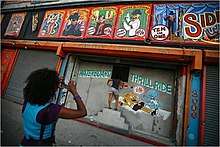Coney Island waterboarding thrill ride

In the summer of 2008 conceptual artist Steve Powers conceived a work that came to be known as the Coney Island waterboarding thrill ride on Coney Island.[1][2][3]
As originally conceived, Powers saw the public watching volunteers undergoing actual waterboarding.[1] The Washington Post reported that on August 17, 2008 Powers brought in Mike Ritz, a former US official experienced in administering waterboarding, for a one time demonstration of waterboarding on volunteers.[2] This demonstration was not open to the general public, but rather for an invited audience. Powers himself was one of the volunteers.
As built, the thrill ride was a diorama, where viewers would mount stairs to a window where they would see a tableau of two models, one a captive, one a masked interrogator. The captive was wearing an orange uniform "non-compliant" captives wear in the United States' Guantanamo Bay detention camps, in Cuba, and was spread-eagled on a tilted table.
When the piece was installed, in July 2008, viewers inserted a dollar the interrogator figure would pour water onto a rag over the captive figures' nose and throat, upon which the captive figure would start convulsing.
The piece was installed in a row of ordinary Coney Island freak shows and concessions. When installed the thrill ride triggered coverage and commentary around the world.[4][5]
The installation's last viewing was on September 14, 2008.[6]
Powers told The New York Times his purpose in preparing the display was educational:
- "What's more obscene, the official position that waterboarding is not torture, or our official position that it's a thrill ride?"[7]
- "Robot waterboarding became a way of exploring the issue without doing any harm. It's putting a unique experience on the table. And it doesn't take a great leap of the imagination to look in there and say: 'That's really what's going on? That's crazy.'"[7]
References
- 1 2 "Steve Powers Wants to See You Get Waterboarded". New York Magazine. 2008-06-27. Archived from the original on 2009-04-19.
- 1 2
Robin Shulman (2008-08-17). "In N.Y., Waterboarding as Dark Art". The Washington Post. Archived from the original on 2011-11-11. Retrieved 2011-11-11.
He first wanted real people to undergo waterboarding for the public, but he realized that might be tricky and limited it to the one-time private experiment. For the public display, with robotic stand-ins, Powers concerned himself with details such as finding music mentioned on blogs as having been played to prisoners at Abu Ghraib and Guantanamo.
mirror - ↑
Julie Bloom (2008-07-30). "Waterboarding as Art". The New York Times. Archived from the original on 2011-11-11. Retrieved 2011-11-11.
The journalist Christopher Hitchens underwent waterboarding for a recent Vanity Fair article. Now an artist is using that interrogation technique — which makes people feel as if they were drowning — to raise awareness of the issue of torture.
- ↑ Will Safer (2008-08-07). "Coney Island's Robotic 'Waterboard Thrill Ride' Evokes Guantanamo". Huffington Post. Archived from the original on 2009-04-17.
- ↑ Ritsuke Ando (2008-08-07). "Waterboarding an attraction at amusement park". Reuters. Archived from the original on 2009-04-17.
- ↑
"The Waterboard Thrill Ride". Brooklynbased. September 2008. Archived from the original on 2009-04-17.
Brooklyn artist Steve Powers’ installation has been up since July beside less menacing Coney Island sideshows: Pay $1, and see an animatronic torturer in action. It should be on view 2-6 on Friday and 2-8, Saturday, Sept. 14, when it closes.
- 1 2 Kaminer, Ariel (7 August 2008). "Coney Island Sideshow Has Guantánamo Theme". The New York Times. Retrieved 20 April 2009.